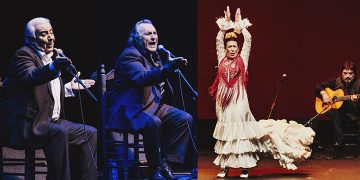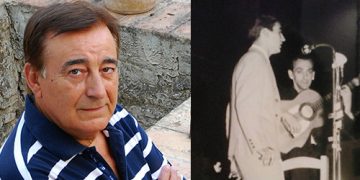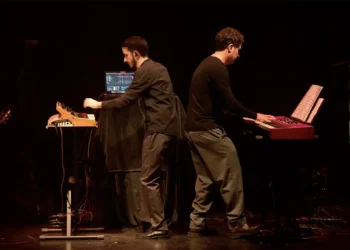|
CALIXTO SÁNCHEZ “UNA FORMA DE CANTAR”
|
||
|
SPECIAL BIENAL DE FLAMENCO DE SEVILLA 2008 Cante: Calixto Sánchez and José de la Mena. Guitar: Manolo Franco and Eduardo Rebollar. Keyboard and percussion: Gustavo Olmedo. Bass: Miguel Vargas. Chorus and palmas: Sara Salado, Davinia Jaén, Carlos Cabello and Pedro el de la Chana. Text: Gonzalo Montaño Peña Yesterday, Thursday, September 11th, at Seville’s Lope de Vega theater, maestro Calixto Sánchez offered “Una Forma de Cantar”, “a way of singing”, an allusion of course to his own form of expression. As the singer himself made clear, his style is based on good pitch, correct throat positioning, maintaining the notes rather than using vibrato and a minimum of melisma or embellishment. By way of demonstration at the beginning of the show, he presented José de Mena, a Mairena singer. The curtain came up to reveal two chairs, an austere and classic staging that gave a clue to what we were about to see. José de la Mena, a classic singer with orthodox repertoire and a well-groomed delivery offered taranta and cartagena in perfect condition, a passionate soleá ,and siguiriyas where the singer gave every bit of himself, without a single extraneous note, but nothing missing either, and always trying to squeeze the most out of the cante. Then Calixto appeared, accompanied by Manolo Franco, to open with one of his characteristic malagueñas in a style that is clean, but perhaps lacking in impetus. He then rendered his adaptation of Federico García Lorca’s poem, “Romance de la Pena Negra”. The cante was carefully measured and of great textural and melodic beauty. Between cantes Calixto explained the fundamentals and evolution of his style. To wrap up the first part of his recital, Calixto interpreted tientos-tangos with verses of poet Fernando Villalón. In my opinion, this is where he achieved the best moments of his performance. The second part of the concert added a grand piano, an electric bass, the second guitar of Eduardo Rebollar, and four choral voices. The singer began with mining cante which gained in rhythmic force from the instrumentals, and the singer appeared to be a flamenco prince. Between cantes, Calixto gives short talks, winning over the audience who laugh at his jokes and are delighted with his anecdotes; this is clearly a facet of performing he dominates well, it’s always good to establish a rapport. Now the singer gets into marianas, and quite frankly, he does a fine job of it. Then, the verses of Machado in “La Lola” set to alegrías, with Calixto rocking back and forth in his seat as if he were crossing Cádiz bay. To close, a bulería song, backed up by arrangements that are momentarily reminiscent of the great Manuel de Falla, although it sounds a bit too much like popular song. The audience accepts and admires this “way of singing” and demands an encore which the maestro is quick to give, thus closing with “La Manolilta”, a bulerías song in which the Cádiz airs remind us of the wonderful Chano Lobato. How can we possibly pass judgement on an artist who twenty-eight years ago won the Giraldillo prize in this very same theater? But like he himself says, “You are the judges”, and this is his vision of cante. And anyone who doesn’t like it, may abstain.
|



 XV BIENAL DE FLAMENCO DE SEVILLA
XV BIENAL DE FLAMENCO DE SEVILLA 

















